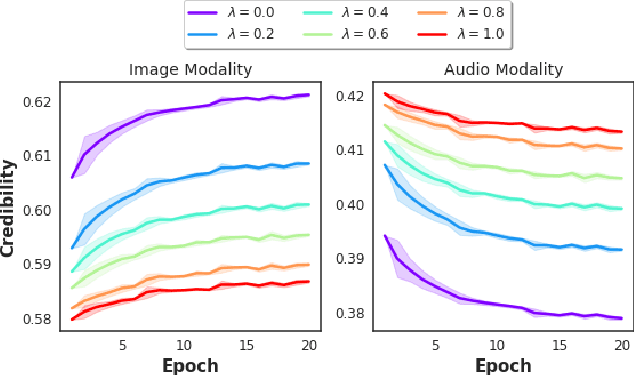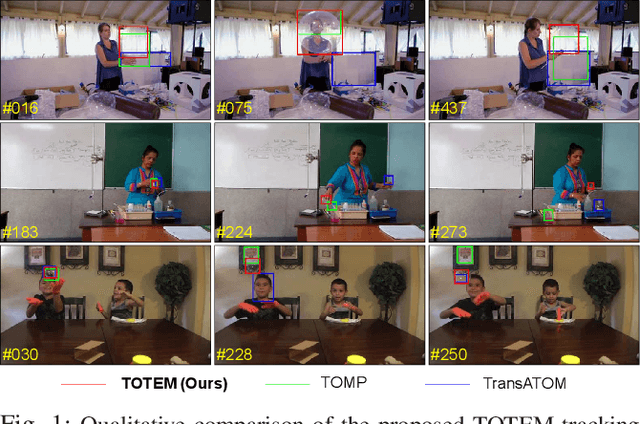Erik Blasch
Air Force Office of Scientific Research
Stone Soup: ADS-B-based Multi-Target Tracking with Stochastic Integration Filter
Jun 09, 2025Abstract:This paper focuses on the multi-target tracking using the Stone Soup framework. In particular, we aim at evaluation of two multi-target tracking scenarios based on the simulated class-B dataset and ADS-B class-A dataset provided by OpenSky Network. The scenarios are evaluated w.r.t. selection of a local state estimator using a range of the Stone Soup metrics. Source code with scenario definitions and Stone Soup set-up are provided along with the paper.
Towards Trustworthy Retrieval Augmented Generation for Large Language Models: A Survey
Feb 08, 2025Abstract:Retrieval-Augmented Generation (RAG) is an advanced technique designed to address the challenges of Artificial Intelligence-Generated Content (AIGC). By integrating context retrieval into content generation, RAG provides reliable and up-to-date external knowledge, reduces hallucinations, and ensures relevant context across a wide range of tasks. However, despite RAG's success and potential, recent studies have shown that the RAG paradigm also introduces new risks, including robustness issues, privacy concerns, adversarial attacks, and accountability issues. Addressing these risks is critical for future applications of RAG systems, as they directly impact their trustworthiness. Although various methods have been developed to improve the trustworthiness of RAG methods, there is a lack of a unified perspective and framework for research in this topic. Thus, in this paper, we aim to address this gap by providing a comprehensive roadmap for developing trustworthy RAG systems. We place our discussion around five key perspectives: reliability, privacy, safety, fairness, explainability, and accountability. For each perspective, we present a general framework and taxonomy, offering a structured approach to understanding the current challenges, evaluating existing solutions, and identifying promising future research directions. To encourage broader adoption and innovation, we also highlight the downstream applications where trustworthy RAG systems have a significant impact.
Stochastic Integration Based Estimator: Robust Design and Stone Soup Implementation
Dec 10, 2024Abstract:This paper deals with state estimation of nonlinear stochastic dynamic models. In particular, the stochastic integration rule, which provides asymptotically unbiased estimates of the moments of nonlinearly transformed Gaussian random variables, is reviewed together with the recently introduced stochastic integration filter (SIF). Using SIF, the respective multi-step prediction and smoothing algorithms are developed in full and efficient square-root form. The stochastic-integration-rule-based algorithms are implemented in Python (within the Stone Soup framework) and in MATLAB and are numerically evaluated and compared with the well-known unscented and extended Kalman filters using the Stone Soup defined tracking scenario.
Towards Trustworthy Knowledge Graph Reasoning: An Uncertainty Aware Perspective
Oct 11, 2024Abstract:Recently, Knowledge Graphs (KGs) have been successfully coupled with Large Language Models (LLMs) to mitigate their hallucinations and enhance their reasoning capability, such as in KG-based retrieval-augmented frameworks. However, current KG-LLM frameworks lack rigorous uncertainty estimation, limiting their reliable deployment in high-stakes applications. Directly incorporating uncertainty quantification into KG-LLM frameworks presents challenges due to their complex architectures and the intricate interactions between the knowledge graph and language model components. To address this gap, we propose a new trustworthy KG-LLM framework, Uncertainty Aware Knowledge-Graph Reasoning (UAG), which incorporates uncertainty quantification into the KG-LLM framework. We design an uncertainty-aware multi-step reasoning framework that leverages conformal prediction to provide a theoretical guarantee on the prediction set. To manage the error rate of the multi-step process, we additionally introduce an error rate control module to adjust the error rate within the individual components. Extensive experiments show that our proposed UAG can achieve any pre-defined coverage rate while reducing the prediction set/interval size by 40% on average over the baselines.
Efficient Temporal Action Segmentation via Boundary-aware Query Voting
May 25, 2024Abstract:Although the performance of Temporal Action Segmentation (TAS) has improved in recent years, achieving promising results often comes with a high computational cost due to dense inputs, complex model structures, and resource-intensive post-processing requirements. To improve the efficiency while keeping the performance, we present a novel perspective centered on per-segment classification. By harnessing the capabilities of Transformers, we tokenize each video segment as an instance token, endowed with intrinsic instance segmentation. To realize efficient action segmentation, we introduce BaFormer, a boundary-aware Transformer network. It employs instance queries for instance segmentation and a global query for class-agnostic boundary prediction, yielding continuous segment proposals. During inference, BaFormer employs a simple yet effective voting strategy to classify boundary-wise segments based on instance segmentation. Remarkably, as a single-stage approach, BaFormer significantly reduces the computational costs, utilizing only 6% of the running time compared to state-of-the-art method DiffAct, while producing better or comparable accuracy over several popular benchmarks. The code for this project is publicly available at https://github.com/peiyao-w/BaFormer.
Credibility-Aware Multi-Modal Fusion Using Probabilistic Circuits
Mar 05, 2024



Abstract:We consider the problem of late multi-modal fusion for discriminative learning. Motivated by noisy, multi-source domains that require understanding the reliability of each data source, we explore the notion of credibility in the context of multi-modal fusion. We propose a combination function that uses probabilistic circuits (PCs) to combine predictive distributions over individual modalities. We also define a probabilistic measure to evaluate the credibility of each modality via inference queries over the PC. Our experimental evaluation demonstrates that our fusion method can reliably infer credibility while maintaining competitive performance with the state-of-the-art.
Image Prior and Posterior Conditional Probability Representation for Efficient Damage Assessment
Oct 26, 2023


Abstract:It is important to quantify Damage Assessment (DA) for Human Assistance and Disaster Response (HADR) applications. In this paper, to achieve efficient and scalable DA in HADR, an image prior and posterior conditional probability (IP2CP) is developed as an effective computational imaging representation. Equipped with the IP2CP representation, the matching pre- and post-disaster images are effectively encoded into one image that is then processed using deep learning approaches to determine the damage levels. Two scenarios of crucial importance for the practical use of DA in HADR applications are examined: pixel-wise semantic segmentation and patch-based contrastive learning-based global damage classification. Results achieved by IP2CP in both scenarios demonstrate promising performances, showing that our IP2CP-based methods within the deep learning framework can effectively achieve data and computational efficiency, which is of utmost importance for the DA in HADR applications.
Transparent Object Tracking with Enhanced Fusion Module
Sep 13, 2023



Abstract:Accurate tracking of transparent objects, such as glasses, plays a critical role in many robotic tasks such as robot-assisted living. Due to the adaptive and often reflective texture of such objects, traditional tracking algorithms that rely on general-purpose learned features suffer from reduced performance. Recent research has proposed to instill transparency awareness into existing general object trackers by fusing purpose-built features. However, with the existing fusion techniques, the addition of new features causes a change in the latent space making it impossible to incorporate transparency awareness on trackers with fixed latent spaces. For example, many of the current days transformer-based trackers are fully pre-trained and are sensitive to any latent space perturbations. In this paper, we present a new feature fusion technique that integrates transparency information into a fixed feature space, enabling its use in a broader range of trackers. Our proposed fusion module, composed of a transformer encoder and an MLP module, leverages key query-based transformations to embed the transparency information into the tracking pipeline. We also present a new two-step training strategy for our fusion module to effectively merge transparency features. We propose a new tracker architecture that uses our fusion techniques to achieve superior results for transparent object tracking. Our proposed method achieves competitive results with state-of-the-art trackers on TOTB, which is the largest transparent object tracking benchmark recently released. Our results and the implementation of code will be made publicly available at https://github.com/kalyan0510/TOTEM.
CCTV-Gun: Benchmarking Handgun Detection in CCTV Images
Apr 02, 2023



Abstract:Gun violence is a critical security problem, and it is imperative for the computer vision community to develop effective gun detection algorithms for real-world scenarios, particularly in Closed Circuit Television (CCTV) surveillance data. Despite significant progress in visual object detection, detecting guns in real-world CCTV images remains a challenging and under-explored task. Firearms, especially handguns, are typically very small in size, non-salient in appearance, and often severely occluded or indistinguishable from other small objects. Additionally, the lack of principled benchmarks and difficulty collecting relevant datasets further hinder algorithmic development. In this paper, we present a meticulously crafted and annotated benchmark, called \textbf{CCTV-Gun}, which addresses the challenges of detecting handguns in real-world CCTV images. Our contribution is three-fold. Firstly, we carefully select and analyze real-world CCTV images from three datasets, manually annotate handguns and their holders, and assign each image with relevant challenge factors such as blur and occlusion. Secondly, we propose a new cross-dataset evaluation protocol in addition to the standard intra-dataset protocol, which is vital for gun detection in practical settings. Finally, we comprehensively evaluate both classical and state-of-the-art object detection algorithms, providing an in-depth analysis of their generalizing abilities. The benchmark will facilitate further research and development on this topic and ultimately enhance security. Code, annotations, and trained models are available at https://github.com/srikarym/CCTV-Gun.
DeFakePro: Decentralized DeepFake Attacks Detection using ENF Authentication
Jul 22, 2022



Abstract:Advancements in generative models, like Deepfake allows users to imitate a targeted person and manipulate online interactions. It has been recognized that disinformation may cause disturbance in society and ruin the foundation of trust. This article presents DeFakePro, a decentralized consensus mechanism-based Deepfake detection technique in online video conferencing tools. Leveraging Electrical Network Frequency (ENF), an environmental fingerprint embedded in digital media recording, affords a consensus mechanism design called Proof-of-ENF (PoENF) algorithm. The similarity in ENF signal fluctuations is utilized in the PoENF algorithm to authenticate the media broadcasted in conferencing tools. By utilizing the video conferencing setup with malicious participants to broadcast deep fake video recordings to other participants, the DeFakePro system verifies the authenticity of the incoming media in both audio and video channels.
 Add to Chrome
Add to Chrome Add to Firefox
Add to Firefox Add to Edge
Add to Edge